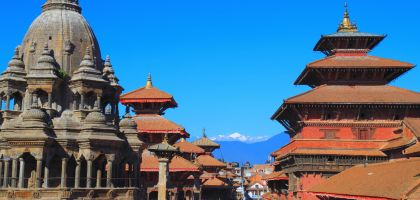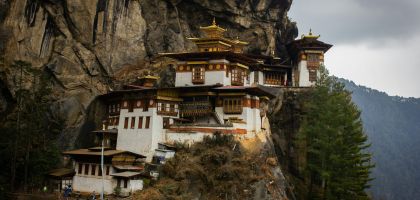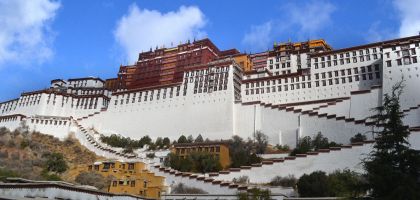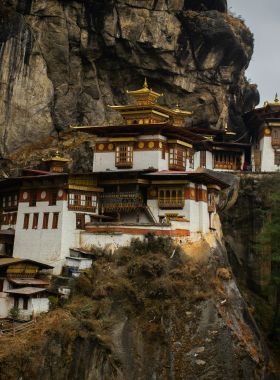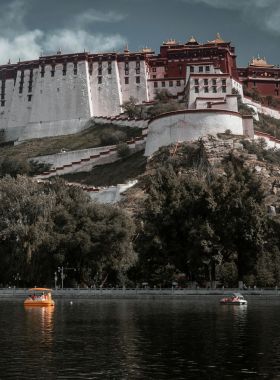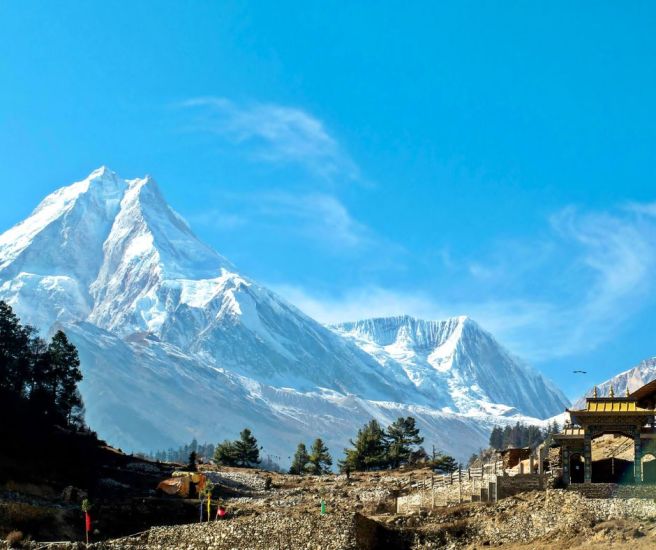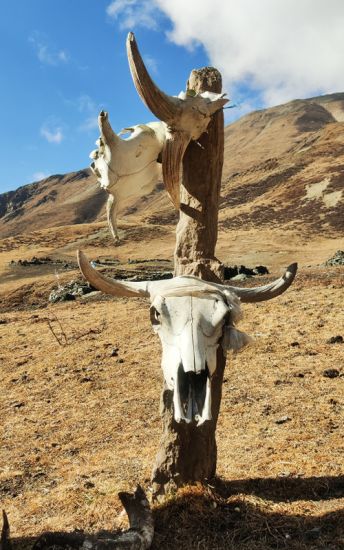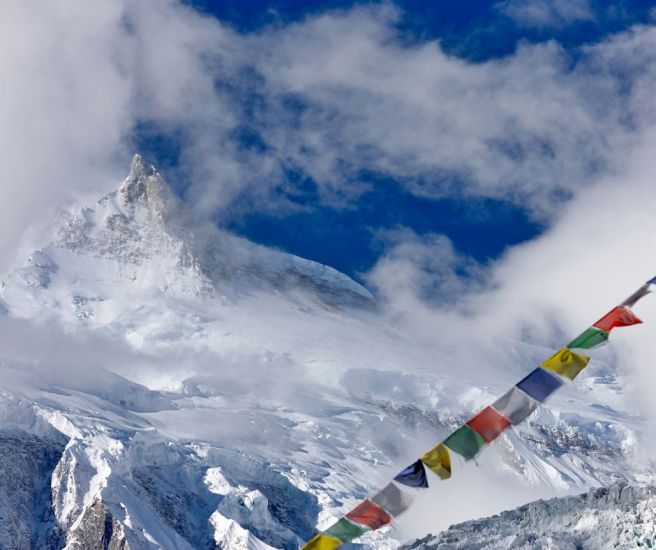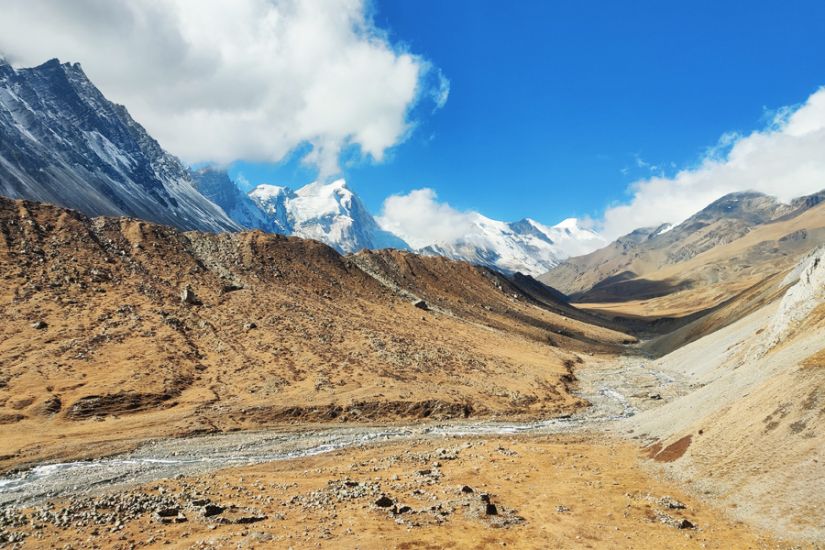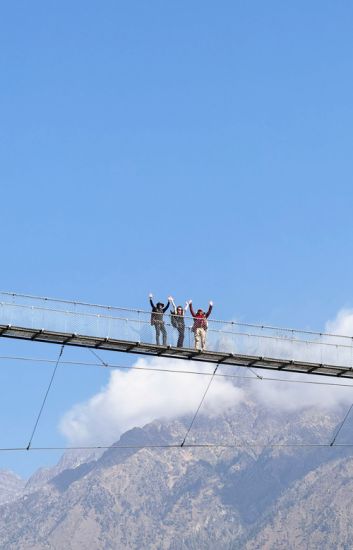Manaslu Circuit and Tsum Valley Trek
20 Days / Nepal
Activity
Difficulty Level
Destinations
Trip Start / End
Max Altitude
Accommodation
Travel Style
Best time to travel
Personalized Travel Advice

Dev Raj Nepal
+977 9851096523
Detailed Itinerary
01
DAY
01
Upon your arrival, you will be warmly welcomed at the airport and comfortably transferred to your hotel. Depending on your arrival time, you have the option to unwind and settle in at your hotel or venture out to explore the vibrant bazaars of Kathmandu. Wander through the lively streets, where the hustle and bustle of local markets offer a perfect introduction to the city’s rich culture and heritage.
Arrival in Kathmandu
Upon your arrival, you will be warmly welcomed at the airport and comfortably transferred to your hotel. Depending on your arrival time, you have the option to unwind and settle in at your hotel or venture out to explore the vibrant bazaars of Kathmandu. Wander through the lively streets, where the hustle and bustle of local markets offer a perfect introduction to the city’s rich culture and heritage.
02
DAY
02
After breakfast, start your day with a visit to Swayambhunath Stupa (Monkey Temple), where you can enjoy panoramic views of Kathmandu Valley and the peaceful atmosphere of this UNESCO site. Next, head to Kathmandu Durbar Square, a historic royal palace complex, surrounded by beautiful temples and ancient architecture.
From there, wander through the vibrant Ason Market, a lively bazaar filled with spices, textiles, and local goods, offering a glimpse into daily life in Kathmandu. Then, explore the bustling streets of Thamel, where you can pick up any last-minute trekking gear or souvenirs.
In the evening, meet with your trekking guide to finalize your preparations. This is a great time to check your gear, discuss the trek details, and get advice on what to expect along the way. By the end of the day, you’ll be ready for your adventure ahead!
Kathmandu: sightseeing and trek preparation
After breakfast, start your day with a visit to Swayambhunath Stupa (Monkey Temple), where you can enjoy panoramic views of Kathmandu Valley and the peaceful atmosphere of this UNESCO site. Next, head to Kathmandu Durbar Square, a historic royal palace complex, surrounded by beautiful temples and ancient architecture.
From there, wander through the vibrant Ason Market, a lively bazaar filled with spices, textiles, and local goods, offering a glimpse into daily life in Kathmandu. Then, explore the bustling streets of Thamel, where you can pick up any last-minute trekking gear or souvenirs.
In the evening, meet with your trekking guide to finalize your preparations. This is a great time to check your gear, discuss the trek details, and get advice on what to expect along the way. By the end of the day, you’ll be ready for your adventure ahead!
03
DAY
03
Our day begins with a hearty breakfast before setting off on a scenic westbound drive along the Prithvi Highway. The route winds through rolling green hills and charming roadside villages until we reach Malekhu. From there, the road meanders past Dhading Besi and begins its ascent to the highlands of Gola Bhanjyang, where sweeping views of the distant snow-cloaked Himalayas await. Descending once more, we cross the gentle flow of the Ankhu Khola and continue toward Arughat, where the powerful Budhi Gandaki River joins our path. Hugging the river’s rugged western bank, we make our final approach to the peaceful village of Machha Khola. Stay overnight at a lodge in Machha Khola.
Drive to Machha Khola
Our day begins with a hearty breakfast before setting off on a scenic westbound drive along the Prithvi Highway. The route winds through rolling green hills and charming roadside villages until we reach Malekhu. From there, the road meanders past Dhading Besi and begins its ascent to the highlands of Gola Bhanjyang, where sweeping views of the distant snow-cloaked Himalayas await. Descending once more, we cross the gentle flow of the Ankhu Khola and continue toward Arughat, where the powerful Budhi Gandaki River joins our path. Hugging the river’s rugged western bank, we make our final approach to the peaceful village of Machha Khola. Stay overnight at a lodge in Machha Khola.
04
DAY
04
Our trek begins with a trail that winds along the Budhi Gandaki River, passing through terraced farmland and small Gurung settlements. We cross several suspension bridges and navigate through lush forests before reaching Tatopani, a natural hot spring where trekkers can take a short break. The trail then ascends through narrow ridges and crosses the Doban River before arriving at Jagat, a checkpoint where permits for the Manaslu Conservation Area are registered.
Trek to Jagat
Our trek begins with a trail that winds along the Budhi Gandaki River, passing through terraced farmland and small Gurung settlements. We cross several suspension bridges and navigate through lush forests before reaching Tatopani, a natural hot spring where trekkers can take a short break. The trail then ascends through narrow ridges and crosses the Doban River before arriving at Jagat, a checkpoint where permits for the Manaslu Conservation Area are registered.
05
DAY
05
Today marks our entry into the restricted area of the Manaslu and Tsum Valley region. Departing from Jagat, we follow the banks of the Budhi Gandaki River, passing through the quaint villages of Salleri, Sirdibas, and Philim. Along the way, we’re treated to glimpses of the majestic Shringi Himal (7,161m). After registering at the checkpoint in Philim, our trail leads us to Ekle Bhatti. Continuing along the river’s edge, we trek past a scenic waterfall before arriving at the serene village of Lokpa. We spend the night at a cozy lodge in Lokpa, surrounded by the tranquil beauty of the mountains.
Trek to Lokpa
Today marks our entry into the restricted area of the Manaslu and Tsum Valley region. Departing from Jagat, we follow the banks of the Budhi Gandaki River, passing through the quaint villages of Salleri, Sirdibas, and Philim. Along the way, we’re treated to glimpses of the majestic Shringi Himal (7,161m). After registering at the checkpoint in Philim, our trail leads us to Ekle Bhatti. Continuing along the river’s edge, we trek past a scenic waterfall before arriving at the serene village of Lokpa. We spend the night at a cozy lodge in Lokpa, surrounded by the tranquil beauty of the mountains.
06
DAY
06
After breakfast, we begin our trek from Lokpa, stepping into the remote and mystical gateway of Tsum Valley. If the skies are clear, the trail offers breathtaking views of Baudha Himal (6,672m) and Ganesh Himal VI as we make our way toward Chumling.
The path first descends into the Lungwa River valley, then winds upward through a lush subtropical forest blanketed with rhododendron and pine trees. This stretch between Lokpa and Chumling is beautifully wild and untouched, with no villages in between. After crossing the Syar Khola, we finally reach the peaceful village of Chumling.
A short side hike to the upper reaches of the village leads to a monastery that rewards you with panoramic views of the Ganesh Himal range. Chumling is home three extremely revered monasteries—Panago Gumba, Mani Dhungyur, and Gurwa Gumba—each adding to the village’s spiritual charm.
Trek to Chumling
After breakfast, we begin our trek from Lokpa, stepping into the remote and mystical gateway of Tsum Valley. If the skies are clear, the trail offers breathtaking views of Baudha Himal (6,672m) and Ganesh Himal VI as we make our way toward Chumling.
The path first descends into the Lungwa River valley, then winds upward through a lush subtropical forest blanketed with rhododendron and pine trees. This stretch between Lokpa and Chumling is beautifully wild and untouched, with no villages in between. After crossing the Syar Khola, we finally reach the peaceful village of Chumling.
A short side hike to the upper reaches of the village leads to a monastery that rewards you with panoramic views of the Ganesh Himal range. Chumling is home three extremely revered monasteries—Panago Gumba, Mani Dhungyur, and Gurwa Gumba—each adding to the village’s spiritual charm.
07
DAY
07
Bidding farewell to the peaceful village of Chumling, we continue our journey deeper into the heart of Tsum Valley, following the course of the Shiar Khola—a modest tributary of the Budhi Gandaki. Throughout the day, the towering peaks of Ganesh Himal grace the horizon, offering a stunning natural backdrop to our ascent.
Our trail crosses several small rivers—Samatikring, Sarpu, and Udilu—and leads us past the quiet hamlet of Gho. Along the way, we encounter a small Tibetan monastery, a gentle reminder of the deep spiritual and cultural ties this valley shares with Tibet.
By late afternoon, we arrive at Chhokang Paro, the largest settlement in the valley. From here, the sweeping views of Ganesh Himal and distant snow-capped peaks provide a perfect reward for the day’s effort.
Trek to Chhokang Paro
Bidding farewell to the peaceful village of Chumling, we continue our journey deeper into the heart of Tsum Valley, following the course of the Shiar Khola—a modest tributary of the Budhi Gandaki. Throughout the day, the towering peaks of Ganesh Himal grace the horizon, offering a stunning natural backdrop to our ascent.
Our trail crosses several small rivers—Samatikring, Sarpu, and Udilu—and leads us past the quiet hamlet of Gho. Along the way, we encounter a small Tibetan monastery, a gentle reminder of the deep spiritual and cultural ties this valley shares with Tibet.
By late afternoon, we arrive at Chhokang Paro, the largest settlement in the valley. From here, the sweeping views of Ganesh Himal and distant snow-capped peaks provide a perfect reward for the day’s effort.
08
DAY
08
Today’s walk is relatively shorter, allowing us to take in the spiritual and cultural richness of the upper Tsum Valley at a relaxed pace. Leaving Chhokang Paro behind, we continue northward through expansive fields and isolated hamlets, with the snow-draped Ganesh Himal ever present on the horizon.
After passing Lamagaon, we reach one of the most sacred sites in the valley—Milarepa’s Piren Phu Cave (Pigeon Cave). This revered cave, nestled into a rocky cliff, is believed to preserve the footprint of the great Tibetan yogi Milarepa. Two small gompas are built into the cave, adorned with richly painted murals, ancient Buddhist manuscripts, and vibrant prayer flags. Piren Phu is not only a spiritual sanctuary but also a remarkable cultural treasure of the Tsum Valley.
As we move forward, we pass through Ngakyu Leru, a fertile area where local villagers tend to their fields—one of the few expanses in the region where farming thrives. We then cross a suspension bridge over the Shiar River, and the trail meanders gently through several quiet settlements.
Eventually, we arrive at Nile, located on the western side of the Shikhar Khola. Just across from Chhule, the last village to the north, Nile sits peacefully in the high valley landscape, offering a sense of serenity and isolation. We’ll spend the night here, preparing for our visit to Mu Gompa the next day.
Trek to Nile
Today’s walk is relatively shorter, allowing us to take in the spiritual and cultural richness of the upper Tsum Valley at a relaxed pace. Leaving Chhokang Paro behind, we continue northward through expansive fields and isolated hamlets, with the snow-draped Ganesh Himal ever present on the horizon.
After passing Lamagaon, we reach one of the most sacred sites in the valley—Milarepa’s Piren Phu Cave (Pigeon Cave). This revered cave, nestled into a rocky cliff, is believed to preserve the footprint of the great Tibetan yogi Milarepa. Two small gompas are built into the cave, adorned with richly painted murals, ancient Buddhist manuscripts, and vibrant prayer flags. Piren Phu is not only a spiritual sanctuary but also a remarkable cultural treasure of the Tsum Valley.
As we move forward, we pass through Ngakyu Leru, a fertile area where local villagers tend to their fields—one of the few expanses in the region where farming thrives. We then cross a suspension bridge over the Shiar River, and the trail meanders gently through several quiet settlements.
Eventually, we arrive at Nile, located on the western side of the Shikhar Khola. Just across from Chhule, the last village to the north, Nile sits peacefully in the high valley landscape, offering a sense of serenity and isolation. We’ll spend the night here, preparing for our visit to Mu Gompa the next day.
09
DAY
09
Today is set aside for acclimatization as we ascend higher into the sacred heart of Tsum Valley. After breakfast in Nile, we begin a steady uphill hike towards Mu Gompa (3,700m), the largest and most remote monastery in the region.
The trail offers sweeping views of the valley as it narrows into dramatic ridgelines and wind-swept plains. The air gets crisper and the landscape more alpine, with solitary chortens and long lines of mani walls whispering centuries of devotion. Along the way, we might spot herds of blue sheep grazing silently on the slopes, blending seamlessly into the stark terrain.
Mu Gompa, nestled beneath towering peaks near the Tibetan border, is a timeless sanctuary where a handful of monks still live in deep prayer and contemplation. The monastery holds a small collection of ancient relics, religious texts, and prayer halls that echo with the soft hum of chants. The surrounding views are nothing short of breathtaking—Ganesh Himal, the seemingly endless ridges of the Himalayas, and the untouched stillness of high-altitude solitude.
For those feeling energetic, an optional side hike to the Dhephu Doma Gompa, located even higher on a ridge, provides a more intimate encounter with monastic life and unmatched panoramic vistas.
We return to Nile for the night, letting our bodies rest and acclimatize to the elevation in preparation for the days ahead.
Acclimatization Day at Nile – Hike to Mu Gompa
Today is set aside for acclimatization as we ascend higher into the sacred heart of Tsum Valley. After breakfast in Nile, we begin a steady uphill hike towards Mu Gompa (3,700m), the largest and most remote monastery in the region.
The trail offers sweeping views of the valley as it narrows into dramatic ridgelines and wind-swept plains. The air gets crisper and the landscape more alpine, with solitary chortens and long lines of mani walls whispering centuries of devotion. Along the way, we might spot herds of blue sheep grazing silently on the slopes, blending seamlessly into the stark terrain.
Mu Gompa, nestled beneath towering peaks near the Tibetan border, is a timeless sanctuary where a handful of monks still live in deep prayer and contemplation. The monastery holds a small collection of ancient relics, religious texts, and prayer halls that echo with the soft hum of chants. The surrounding views are nothing short of breathtaking—Ganesh Himal, the seemingly endless ridges of the Himalayas, and the untouched stillness of high-altitude solitude.
For those feeling energetic, an optional side hike to the Dhephu Doma Gompa, located even higher on a ridge, provides a more intimate encounter with monastic life and unmatched panoramic vistas.
We return to Nile for the night, letting our bodies rest and acclimatize to the elevation in preparation for the days ahead.
10
DAY
10
Today, we begin our descent from the upper reaches of Tsum Valley, retracing our steps through its sacred heartlands. The trail leads us from Nile through Chhule and onward to Phurbe, where traditional Sherpa homes line the path, offering glimpses into the enduring mountain lifestyle.
We follow the banks of the Siyar River, moving through open meadows and quiet stretches occasionally traced by power lines. Soon, we arrive at Rachen Gompa, a revered Buddhist nunnery set in a tranquil clearing. On a clear day, this spiritual retreat rewards us with serene views of Kipu Himal rising in the distance.
Continuing southward, we pass familiar villages—Chhokang Paro, Domje, Kowo, and Tanju—each one echoing with the spirit of Tibetan Buddhist culture. Prayer flags flutter in the wind, and mani walls line the path, guiding us gently back through this timeless valley.
By late afternoon, we return to Chumling, where we’ll spend the night once more beneath the sheltering peaks and starlit skies of Tsum.
Trek to Chumling
Today, we begin our descent from the upper reaches of Tsum Valley, retracing our steps through its sacred heartlands. The trail leads us from Nile through Chhule and onward to Phurbe, where traditional Sherpa homes line the path, offering glimpses into the enduring mountain lifestyle.
We follow the banks of the Siyar River, moving through open meadows and quiet stretches occasionally traced by power lines. Soon, we arrive at Rachen Gompa, a revered Buddhist nunnery set in a tranquil clearing. On a clear day, this spiritual retreat rewards us with serene views of Kipu Himal rising in the distance.
Continuing southward, we pass familiar villages—Chhokang Paro, Domje, Kowo, and Tanju—each one echoing with the spirit of Tibetan Buddhist culture. Prayer flags flutter in the wind, and mani walls line the path, guiding us gently back through this timeless valley.
By late afternoon, we return to Chumling, where we’ll spend the night once more beneath the sheltering peaks and starlit skies of Tsum.
11
DAY
11
After a hearty breakfast in Chumling, we bid farewell to Tsum Valley and begin our descent toward the Budhi Gandaki Valley. The trail winds through lush forests and quiet hillsides as we retrace our steps toward Lokpa, the junction where the Tsum Valley route meets the main Manaslu Circuit Trail once again.
From Lokpa, the path drops steeply through dense woodland, with occasional glimpses of distant waterfalls and rocky cliffs. As we descend into the narrow gorge carved by the Budhi Gandaki River, the air grows warmer and the vegetation changes noticeably.
We continue past Ekle Bhatti, then cross several suspension bridges, navigating ups and downs along the riverside trail. The roaring Budhi Gandaki accompanies us as we press on through scattered hamlets and terraced fields tucked into the hillsides.
Eventually, we reach Deng, a small yet charming village perched near the riverbank, marking our reentry into the heart of the Manaslu region. Tonight, we rest in Deng, surrounded by forested ridges and the soothing sound of the river below.
Trek to Deng
After a hearty breakfast in Chumling, we bid farewell to Tsum Valley and begin our descent toward the Budhi Gandaki Valley. The trail winds through lush forests and quiet hillsides as we retrace our steps toward Lokpa, the junction where the Tsum Valley route meets the main Manaslu Circuit Trail once again.
From Lokpa, the path drops steeply through dense woodland, with occasional glimpses of distant waterfalls and rocky cliffs. As we descend into the narrow gorge carved by the Budhi Gandaki River, the air grows warmer and the vegetation changes noticeably.
We continue past Ekle Bhatti, then cross several suspension bridges, navigating ups and downs along the riverside trail. The roaring Budhi Gandaki accompanies us as we press on through scattered hamlets and terraced fields tucked into the hillsides.
Eventually, we reach Deng, a small yet charming village perched near the riverbank, marking our reentry into the heart of the Manaslu region. Tonight, we rest in Deng, surrounded by forested ridges and the soothing sound of the river below.
12
DAY
12
Leaving Deng behind, we begin our journey deeper into the culturally rich Nubri Valley. The trail today offers a steady mix of ascents and descents, crossing a series of suspension bridges over the roaring Budhi Gandaki River.
We pass through small settlements like Rana and Bihi, where Mani walls and chortens hint at the increasing influence of Tibetan Buddhism. The landscape gradually changes—lush forests of pine and oak give way to alpine vegetation, and the air begins to thin as we gain altitude.
Along the way, you’ll catch glimpses of Manaslu and other snow-capped peaks peeking through the trees, teasing what’s to come. At times, the path cuts across narrow gorges and follows steep cliffside trails, making the journey both thrilling and scenic.
After a long yet rewarding trek, we reach Namrung, a traditional village known for its stone houses, friendly locals, and beautiful views of Ganesh Himal, Himal Chuli, and Siringi Himal. Namrung also serves as a checkpoint for entering the restricted areas of the upper Manaslu region.
We settle in here for the night, surrounded by Himalayan silence and the cultural richness of the Tibetan-influenced highlands.
Trek to Namrung
Leaving Deng behind, we begin our journey deeper into the culturally rich Nubri Valley. The trail today offers a steady mix of ascents and descents, crossing a series of suspension bridges over the roaring Budhi Gandaki River.
We pass through small settlements like Rana and Bihi, where Mani walls and chortens hint at the increasing influence of Tibetan Buddhism. The landscape gradually changes—lush forests of pine and oak give way to alpine vegetation, and the air begins to thin as we gain altitude.
Along the way, you’ll catch glimpses of Manaslu and other snow-capped peaks peeking through the trees, teasing what’s to come. At times, the path cuts across narrow gorges and follows steep cliffside trails, making the journey both thrilling and scenic.
After a long yet rewarding trek, we reach Namrung, a traditional village known for its stone houses, friendly locals, and beautiful views of Ganesh Himal, Himal Chuli, and Siringi Himal. Namrung also serves as a checkpoint for entering the restricted areas of the upper Manaslu region.
We settle in here for the night, surrounded by Himalayan silence and the cultural richness of the Tibetan-influenced highlands.
13
DAY
13
Today, the trail climbs steadily through forests of fir, rhododendron, and oak, opening up to expansive views of the surrounding mountains. The air is crisp and refreshing, and the Himalayan peaks begin to dominate the skyline more boldly with each step.
Passing through the charming village of Lihi, adorned with barley fields and intricately carved Mani walls, we continue toward Sho, another traditional settlement where Tibetan culture is strongly felt. With every village we pass, the architecture, language, and prayer flags fluttering in the wind speak to the spiritual atmosphere of this sacred region.
The scenery becomes increasingly majestic as we approach Lho, home to the imposing Ribung Gompa and a stunning panoramic view of Mount Manaslu (8,163m)—the eighth-highest mountain in the world.
From Lho, a gentle climb through alpine meadows and yak pastures leads us to Shyala, a quiet highland village perched on a wide plateau. Shyala is surrounded by a gallery of Himalayan giants—Manaslu, Himal Chuli, Ngadi Chuli, and even glimpses of Ganesh Himal on a clear day. Overnight at Shyala.
Trek to Shyala
Today, the trail climbs steadily through forests of fir, rhododendron, and oak, opening up to expansive views of the surrounding mountains. The air is crisp and refreshing, and the Himalayan peaks begin to dominate the skyline more boldly with each step.
Passing through the charming village of Lihi, adorned with barley fields and intricately carved Mani walls, we continue toward Sho, another traditional settlement where Tibetan culture is strongly felt. With every village we pass, the architecture, language, and prayer flags fluttering in the wind speak to the spiritual atmosphere of this sacred region.
The scenery becomes increasingly majestic as we approach Lho, home to the imposing Ribung Gompa and a stunning panoramic view of Mount Manaslu (8,163m)—the eighth-highest mountain in the world.
From Lho, a gentle climb through alpine meadows and yak pastures leads us to Shyala, a quiet highland village perched on a wide plateau. Shyala is surrounded by a gallery of Himalayan giants—Manaslu, Himal Chuli, Ngadi Chuli, and even glimpses of Ganesh Himal on a clear day. Overnight at Shyala.
14
DAY
14
After breakfast in Shyala, we continue our trek with a relatively easy and scenic walk toward Sama Gaon, the largest village in the Nubri Valley. The trail meanders through open pastures and alpine terrain, flanked by awe-inspiring views of Manaslu, Himal Chuli, and Ngadi Chuli. As we near Sama Gaon, the massive icefall and glacial flows of Manaslu begin to dominate the horizon.
Sama Gaon sits at the foot of Manaslu and has a deep influence of Tibetan Buddhist culture, with beautifully carved Mani walls, prayer wheels, and chortens dotting the landscape. After settling in and a short rest, we take a side hike to the shimmering Birendra Lake, a glacial lake formed by the Manaslu Glacier. Nestled beneath towering cliffs and ice masses, the turquoise waters of the lake reflect the snowy peaks, offering a moment of serene stillness.
This gentle acclimatization hike is perfect for adjusting to the higher elevation while taking in one of the most scenic spots in the region. The lake area is also rich in birdlife and offers great photographic opportunities.
We return to Sama Gaon for the night.
Shyala to Sama Gaon Hike to Birendra Lake
After breakfast in Shyala, we continue our trek with a relatively easy and scenic walk toward Sama Gaon, the largest village in the Nubri Valley. The trail meanders through open pastures and alpine terrain, flanked by awe-inspiring views of Manaslu, Himal Chuli, and Ngadi Chuli. As we near Sama Gaon, the massive icefall and glacial flows of Manaslu begin to dominate the horizon.
Sama Gaon sits at the foot of Manaslu and has a deep influence of Tibetan Buddhist culture, with beautifully carved Mani walls, prayer wheels, and chortens dotting the landscape. After settling in and a short rest, we take a side hike to the shimmering Birendra Lake, a glacial lake formed by the Manaslu Glacier. Nestled beneath towering cliffs and ice masses, the turquoise waters of the lake reflect the snowy peaks, offering a moment of serene stillness.
This gentle acclimatization hike is perfect for adjusting to the higher elevation while taking in one of the most scenic spots in the region. The lake area is also rich in birdlife and offers great photographic opportunities.
We return to Sama Gaon for the night.
15
DAY
15
Leaving the tranquil village of Sama Gaon behind, we ascend gradually through a wide, windswept valley alongside the Budhi Gandaki River. The landscape opens up dramatically, with fewer trees and a greater sense of remoteness. Towering peaks like Manaslu, Pang Phuchi, and other snow-draped giants continue to follow us like silent guardians.
The trail leads us past long Mani walls and ancient stone huts as we walk above the tree line. After crossing a wooden bridge over the river, we begin to see the signs of the harsh but beautiful alpine environment—rocky cliffs, grazing yaks, and fluttering prayer flags strung between cairns.
By midday, we reach Samdo (3,860m), a picturesque and windswept settlement just a few kilometers from the Tibetan border. This is the highest permanently inhabited village in the region and home to Tibetan refugees. With its cluster of stone houses and dramatic backdrop of snow-capped peaks, Samdo offers both cultural richness and jaw-dropping scenery.
We spend the afternoon acclimatizing, exploring the village, or hiking up nearby ridges for breathtaking views of the surrounding Himalayan wilderness. Overnight stay in Samdo.
Trek to Samdo
Leaving the tranquil village of Sama Gaon behind, we ascend gradually through a wide, windswept valley alongside the Budhi Gandaki River. The landscape opens up dramatically, with fewer trees and a greater sense of remoteness. Towering peaks like Manaslu, Pang Phuchi, and other snow-draped giants continue to follow us like silent guardians.
The trail leads us past long Mani walls and ancient stone huts as we walk above the tree line. After crossing a wooden bridge over the river, we begin to see the signs of the harsh but beautiful alpine environment—rocky cliffs, grazing yaks, and fluttering prayer flags strung between cairns.
By midday, we reach Samdo (3,860m), a picturesque and windswept settlement just a few kilometers from the Tibetan border. This is the highest permanently inhabited village in the region and home to Tibetan refugees. With its cluster of stone houses and dramatic backdrop of snow-capped peaks, Samdo offers both cultural richness and jaw-dropping scenery.
We spend the afternoon acclimatizing, exploring the village, or hiking up nearby ridges for breathtaking views of the surrounding Himalayan wilderness. Overnight stay in Samdo.
16
DAY
16
Today’s trek takes you through diverse landscapes with stunning mountain views. From Samdo, cross the Budhi Gandaki River and pass Larkya Bazaar before reaching Pana Danda Valley. The trail continues through grassy slopes, descending to Syacha Khola Valley, where you’ll enjoy views of the Syacha Glacier and snow-capped peaks. The final stretch leads you to Larkya Glacier, offering spectacular views of Larke Peak and Naike Peak. After this rewarding trek, you’ll arrive at Dharamsala for an overnight stay amidst the beauty of the Manaslu region. Overnight at a Teahouse.
Trek to Dharamshala
Today’s trek takes you through diverse landscapes with stunning mountain views. From Samdo, cross the Budhi Gandaki River and pass Larkya Bazaar before reaching Pana Danda Valley. The trail continues through grassy slopes, descending to Syacha Khola Valley, where you’ll enjoy views of the Syacha Glacier and snow-capped peaks. The final stretch leads you to Larkya Glacier, offering spectacular views of Larke Peak and Naike Peak. After this rewarding trek, you’ll arrive at Dharamsala for an overnight stay amidst the beauty of the Manaslu region. Overnight at a Teahouse.
17
DAY
17
Today marks one of the most thrilling and rewarding moments of the entire trek—the crossing of the Larkya La Pass, a high mountain pass that links the Budhi Gandaki and Dudh Khola valleys. We start before dawn, with headlamps lighting the way as we slowly ascend the icy trail under a blanket of stars.
The climb is steady and challenging, traversing a rugged glacial moraine surrounded by a majestic wall of snow-covered peaks. As we gain altitude, we’re rewarded with astonishing views of Himlung Himal (7,126m), Cheo Himal, Kangguru, and the Annapurna II massif shimmering under the morning light.
Reaching the Larkya La Pass at 5,160 meters, we’re greeted by fluttering prayer flags and a 360-degree panorama that leaves us breathless—both from the altitude and the sheer grandeur of the Himalayas.
From the pass, we begin a long and steep descent over a rocky and snowy trail, eventually giving way to grassy slopes and rhododendron forests as we lose elevation. The landscape shifts dramatically as we approach Bhimtang (3,590m)—a beautiful high alpine valley surrounded by glaciers and towering peaks.
After a long yet unforgettable day, we rest in this tranquil mountain haven, reflecting on the incredible journey so far. Overnight at Bhimtang.
Trek to Larkye-La & Hike to Bhimtang
Today marks one of the most thrilling and rewarding moments of the entire trek—the crossing of the Larkya La Pass, a high mountain pass that links the Budhi Gandaki and Dudh Khola valleys. We start before dawn, with headlamps lighting the way as we slowly ascend the icy trail under a blanket of stars.
The climb is steady and challenging, traversing a rugged glacial moraine surrounded by a majestic wall of snow-covered peaks. As we gain altitude, we’re rewarded with astonishing views of Himlung Himal (7,126m), Cheo Himal, Kangguru, and the Annapurna II massif shimmering under the morning light.
Reaching the Larkya La Pass at 5,160 meters, we’re greeted by fluttering prayer flags and a 360-degree panorama that leaves us breathless—both from the altitude and the sheer grandeur of the Himalayas.
From the pass, we begin a long and steep descent over a rocky and snowy trail, eventually giving way to grassy slopes and rhododendron forests as we lose elevation. The landscape shifts dramatically as we approach Bhimtang (3,590m)—a beautiful high alpine valley surrounded by glaciers and towering peaks.
After a long yet unforgettable day, we rest in this tranquil mountain haven, reflecting on the incredible journey so far. Overnight at Bhimtang.
18
DAY
18
The trail descends swiftly, dipping in and out of glacial terrain before gradually leading into the lower valley through serene forested paths. As we follow the riverbank once again, we continue our descent, passing by Surki Khola and the quaint village of Goa, steadily losing elevation along the way. The downhill journey brings us to Tilije, and from there, a short uphill climb takes us to Dharapani, where we officially join the renowned Annapurna Circuit trail. Overnight stay in Dharapani.
Trek to Dharapani
The trail descends swiftly, dipping in and out of glacial terrain before gradually leading into the lower valley through serene forested paths. As we follow the riverbank once again, we continue our descent, passing by Surki Khola and the quaint village of Goa, steadily losing elevation along the way. The downhill journey brings us to Tilije, and from there, a short uphill climb takes us to Dharapani, where we officially join the renowned Annapurna Circuit trail. Overnight stay in Dharapani.
19
DAY
19
After bidding farewell to the stunning landscapes of Manaslu and Tsum, we begin our journey back to Kathmandu. We first drive from Dharapani to Besisahar, the main gateway to the Annapurna Circuit, where we change vehicles for a more comfortable ride. The scenic drive takes us through picturesque hill villages, terraced fields, and riverside settlements, offering a final glimpse of rural Nepal’s charm. After arriving in Besisahar, we continue the drive towards Kathmandu, which takes around 6-8 hours. Once we reach the capital, you can unwind and reflect on the unforgettable journey. Overnight in Kathmandu.
Drive to Kathmandu
After bidding farewell to the stunning landscapes of Manaslu and Tsum, we begin our journey back to Kathmandu. We first drive from Dharapani to Besisahar, the main gateway to the Annapurna Circuit, where we change vehicles for a more comfortable ride. The scenic drive takes us through picturesque hill villages, terraced fields, and riverside settlements, offering a final glimpse of rural Nepal’s charm. After arriving in Besisahar, we continue the drive towards Kathmandu, which takes around 6-8 hours. Once we reach the capital, you can unwind and reflect on the unforgettable journey. Overnight in Kathmandu.
20
DAY
20
Today, after breakfast, you will be transferred to the airport for departure.
Departure
Today, after breakfast, you will be transferred to the airport for departure.
Includes / Excludes
Inclusions
-
Airports pick up and drop off, upon arrival and departure in Kathmandu.
-
Accommodations on Twin Sharing basis
-
Trained Guide
-
Meals mentioned in the itinerary
-
Porter
-
Seasonal fresh fruits as Available
-
Vehicles and transfers
-
Manaslu Special trekking permit fee.
-
Manaslu Conservation Area entrance permit fee.
-
Annapurna Conservation Area entrance permit fee.
Exclusions
-
International airfare
-
Nepal entry visa fee
-
Travel insurance
-
All alcoholic drinks
-
Services not mentioned
-
Meals not mentioned
-
Tips for the guide and porter
Trip Info
The best time to do the Manaslu Circuit Trek with Tsum Valley is during the spring (March to May) and autumn (mid-September to mid-November) seasons, when weather is stable, skies are clear, and the mountain views are at their best.
Spring (March to May): Expect daytime temperatures ranging from 10°C to 20°C at lower elevations, and -6°C to 5°C at higher altitudes like Larkya La. This season brings blooming rhododendrons, lush forests, and vibrant trails, all set against crystal-clear views of Manaslu, Ganesh Himal, and Shringi Himal.
Autumn (mid-September to mid-November): Temperatures range from 10°C to 18°C in the lower regions and can dip to -10°C near the pass. After the monsoon, the air is crisp and the skies are brilliantly clear—ideal for photography, high-altitude crossings, and experiencing the rich Tibetan-influenced culture of the Tsum Valley.
Throughout the trip, private vehicles will be used for transfers and sightseeing. These include comfortable cars or SUVs, which are good for navigating both urban and rural areas. These vehicles are chosen for their comfort and reliability, ensuring a smooth and enjoyable journey between destinations. They are equipped to handle various road conditions and provide a high level of convenience for travelers.
Food on the Manaslu Circuit and Tsum Valley Trek offers a delightful mix of traditional Nepali and Tibetan cuisine, providing trekkers with local flavors and ingredients. Dal Bhat, a hearty and nutritious meal consisting of rice, lentil soup, and vegetables, is a staple in Nepali trekking cuisine and is often served multiple times a day. It’s usually accompanied by a side of pickle for extra flavor. Momo, steamed or fried dumplings filled with meat or vegetables, are a popular snack or lunch option along the trail. For breakfast, Tibetan bread, a type of flatbread served with butter or jam, is commonly enjoyed, providing energy for the day ahead. Warm soups, such as vegetable soup, noodle soup, or thukpa (a Tibetan noodle soup), are common, offering comfort and warmth, especially in the colder regions.
In Kathmandu, the accommodations are more modern and comfortable, with a range of hotels available that cater to different budgets. You can expect private rooms with en-suite bathrooms, hot showers, and other amenities like Wi-Fi and room service, providing a relaxing stay before and after your trek.
In the higher-altitude regions of the Manaslu Circuit and Tsum Valley Trek, accommodations consist of teahouses, which are simple, family-run lodges that provide a place to sleep, meals, and a warm environment. Teahouses are basic but functional, with rooms typically featuring twin beds, wooden floors, and a blanket for warmth. Some teahouses may offer additional amenities such as hot water (for a fee) or charging facilities, though this varies from place to place. Though the accommodations in the teahouses can be simple, they are a fundamental part of the trekking experience, allowing trekkers to connect with the local culture and landscape while enjoying the warmth and hospitality of the local people.
Clothing & Footwear
- Waterproof and breathable jacket and pants
- Insulating layers (fleece, down jacket)
- Thermal base layers
- Hiking pants and shorts
- Warm hat and sun hat
- Gloves
- Warm socks
- Sturdy, waterproof hiking boots
- Comfortable sandals or shoes
Gear & Accessories
- Backpack (50-70 liters)
- Sleeping bag (rated for cold temperatures)
- Trekking poles
- Headlamp with extra batteries
- Sunglasses
- Sunscreen and lip balm
- Water bottles or hydration system
- Water purification tablets or filter
- Toiletries
- Quick-dry towel
Remember to pack light and efficiently.
Trekking the Manaslu Circuit with Tsum Valley is an extraordinary journey—but like any adventure into remote Himalayan wilderness, it comes with both challenges and profound rewards. The biggest risks include altitude sickness, particularly around Larkya La Pass (5,160m), where oxygen levels drop and symptoms like headaches, fatigue, or nausea may occur. Weather can also be unpredictable, especially in early spring and late autumn, with sudden snowfall or cold snaps at higher altitudes. Trails in the Tsum Valley are less trodden and more rugged than the standard Manaslu Circuit, which means fewer tea houses, limited mobile signals, and occasional logistical delays due to landslides or difficult terrain.
However, the rewards far outweigh the risks for those prepared and properly acclimatized. You’ll traverse through landscapes that shift dramatically—from deep river gorges and ancient pine forests to high-altitude glaciers and wide, windswept valleys. Unlike the classic Manaslu route, this extension into the Tsum Valley offers a rare cultural immersion, where Tibetan Buddhist monasteries, yak pastures, and centuries-old traditions still flourish untouched by mass tourism. With awe-inspiring views of Ganesh Himal, Himalchuli, and Mount Manaslu, as well as the serenity of sacred sites like Mu Gompa and Rachen Nunnery, this trek is as spiritually enriching as it is visually unforgettable.
A True Off-the-Beaten-Path Experience
Unlike the more frequented Annapurna or Everest trails, the Manaslu Circuit with Tsum Valley trek offers genuine isolation. Once you veer into Tsum Valley, you’ll notice the stark difference: the landscape becomes more rugged, villages sparser, and interactions more intimate. You may walk hours without seeing another trekker, giving you a deeper sense of wilderness and solitude. This isn’t a trek filled with fancy bakeries or gear shops—it’s raw, wild, and authentic.
Deeply Preserved Culture
Tsum Valley is one of the few places where Tibetan Buddhism thrives untouched. Locals still speak a unique Tibetan dialect, barter goods instead of selling them, and celebrate ancient festivals not found elsewhere in Nepal. Many travelers are surprised by the number of centuries-old monasteries, mani walls, and prayer wheels that line the trail—some hidden just a few steps off the path, waiting to be discovered.
Basic Infrastructure
Accommodations here are modest, often family-run tea houses with shared toilets and wood-fire kitchens. Electricity is limited, and Wi-Fi is either unavailable or extremely slow—making this an accidental but refreshing digital detox. Hot showers, if available, usually cost extra and may be solar-heated or bucket-style. It’s best to carry power banks, water purification tablets, and extra snacks, especially for stretches in Tsum where shops are few and far between.
Unexpected Beauty & Challenge
Trekkers often say they weren’t prepared for just how spectacular and diverse the landscapes are—from lush valleys and terraced fields to glacier crossings and Himalayan giants like Manaslu and Ganesh Himal. But this beauty comes with challenge: long walking days, high altitude, and changing weather demand good fitness and flexibility. That said, the rewards are immense—a deeper connection to the land, fewer crowds, and memories that feel earned rather than handed to you.
FAQs
Personalized Travel Advice

Dev Raj Nepal
+977 9851096523
